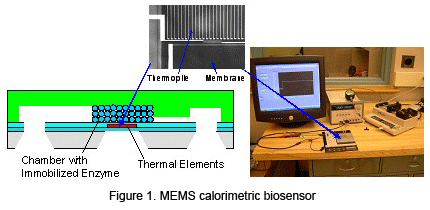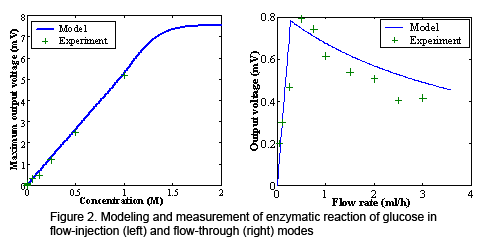| Welcome | People | Research | Presentations | Publications | Facilities | Links |
|---|
|
|
|
|
|
> MEMS Calorimetry |
MEMS Calorimeters for Thermodynamic Characterization of Biomolecules

![]()
Calorimetry concerns the measurement of heat to understand the thermodynamic properties of the process under investigation.
Calorimetry of biological systems is a widely used and critically important tool in biological sciences.
Conventional calorimeters are bulky, expensive and consume large amounts of often precious or rare biological molecules.
We are developing MEMS calorimeters that will eliminate or greatly alleviate such problems.
The MEMS calorimeter, in an early-stage design, features a freestanding membrane on which a thin-film thermopile, a resistive heater and a microfluidic unit are integrated.
The freestanding membrane offers maximal thermal isolation. The microfluidic unit, consisting of a measurement chamber and access channels, has a minimal thermal mass while allowing automated, precise sample handling.
The heat absorbed or evolved in a biomolecular reaction in the chamber is detected by the thermopile, and can be used to determine the thermodynamic properties of the biological sample.
We have explored the MEMS calorimeter as an integrated thermal biosensor for detection of enzymatic reactions. Here enzyme molecules are attached to glass or polymer microbeads, which are in turn packed inside the microfluidic chamber (less than 1 ul in volume). The sample is introduced into the measurement chamber, either as a continuous flow or a single-batch injection, and detected through its enzymatic reaction heat. As an example, this integrated device (Figure 1) has been used to detect the following exothermic enzymatic reaction of glucose:


![]() Test results have shown that glucose can be detected within physiologically relevant concentrations ranges.
To understand the behavior of the integrated MEMS thermal biosensor, we have also developed a closed-form model that considers enzyme kinetics and heat transfer in the microdevice.
The model has shown excellent agreement with the experimental data (Figure 2).
Test results have shown that glucose can be detected within physiologically relevant concentrations ranges.
To understand the behavior of the integrated MEMS thermal biosensor, we have also developed a closed-form model that considers enzyme kinetics and heat transfer in the microdevice.
The model has shown excellent agreement with the experimental data (Figure 2).
Researchers
Li Wang , Ph.D. Student (ME)
Eunice Ng, Undergraduate Student (ECE)